Where Media Meets Statecraft: Daesh Promotion of Governmental Competence through its Media
archive

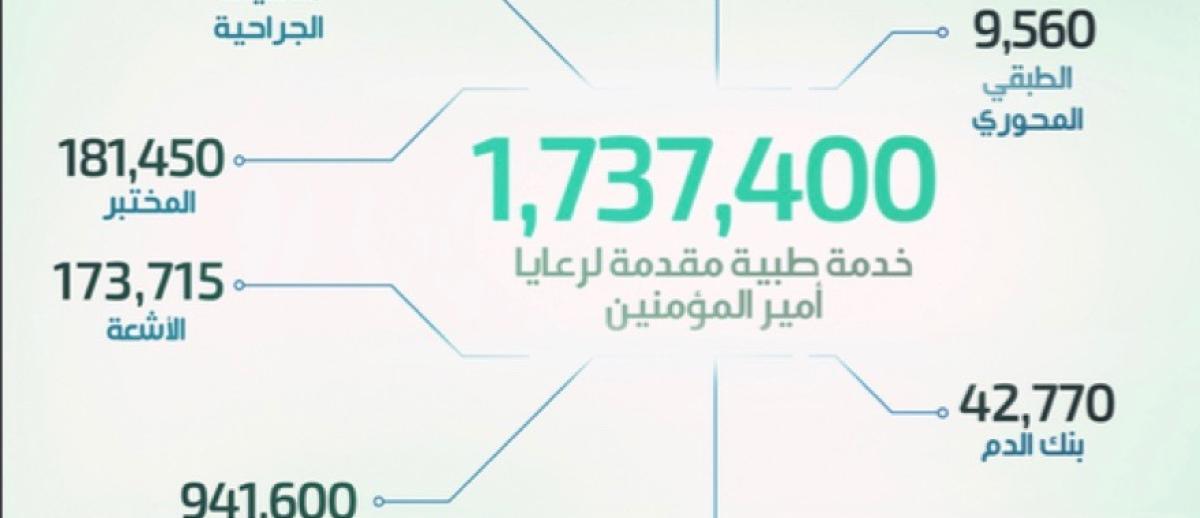
Where Media Meets Statecraft: Daesh Promotion of Governmental Competence through its Media
Daesh media production is complex, multifaceted, and is arguably a representational microcosm of the organization as a whole. Claiming universality as an Islamic State for the entire Muslim Umma, debates about its statehood status continue without clear resolution. In this essay I argue that, rather than a proto-state, a failed state, or a functioning state, Daesh isn’t a state at all in the normal sense; it is an incomplete state. By analyzing infographics published in issues 10-74 of the Arabic language al-Naba’ magazine, issued by Daesh between December 19, 2015 and March 30, 2017, we can think more deeply about this incomplete statehood, and how these infographics try to patch it over. The subject at hand is at the crux of studies of jihadi media use and debates about the nature of the state.
Expanding historical scholarship on Daesh has removed any mystery behind the group’s origins and shows how the genesis of Daesh contributes to this emphasis on statecraft. Daesh has been shown in numerous scholarly works to have arisen from Zarqawi’s faction that broke away from Al-Qaeda, changing names several times in the 2000’s before becoming “ISIS” and then “IS” in their own parlance.1 Zarqawi was intent on seizing and governing territory as well as establishing a caliphate, something Bin Laden and Zawahiri came to view as a mistake that they counseled Zarqawi and others against. After shocking the world with its “success” in 2014, Daeshi’s claim to statehood was not only not recognized by other nation-states, but they also refused to call it the “Islamic State.” Daesh thus saw its aspirations doubted by other jihadis before even moving to realize them, and saw a complete refusal by the West to acknowledge its statehood after the declaration of the Caliphate.
While Daesh may be relatively new and its publication al-Naba’ even younger, previous iterations of Daesh had already been making propaganda for years, as had their close organizational cousins Al-Qaeda.2 The group expanded media efforts from 2011-2014 and founded multiple new outlets that shape what we talk about when we focus on Daesh media in 2017.3 These include the founding of Al-Naba’, Amaq News Agency, Telegram channels, and the al-Bayan radio station. In al-Naba’, we see attempts to display the most basic element of statehood: the monopoly over the coercive use of violence. The overwhelming majority of the content in my sample of Daesh media consulted for this research depicts violence or reports the carrying out of violent punishments and attacks. The group’s propaganda used to be directed inward at its followers, but it also now seeks to terrorize non-Muslims most broadly. Infographics about statecraft seek to prove wrong those who doubted Daesh, while reinforcing the paternal and nurturing aspects of the state.
States traditionally want to control education and the narratives taught in schools, and Daesh is no exception. An infographic from March 2016 claimed that some 43,000 people took shari‘a courses over the previous 6 months in Daesh territories in Syria. (Graphic 1, below) Another measures a full year from mid-2015 through mid-2016 in Iraqi provinces, totaling 2,500 classes and lectures, while curiously not providing documentation of the number of students who attended such classes. (Graphic 2, below) Defectors describe being forced to take these courses. A different facet of education relates to public awareness; Daesh created multiple public “media points” where citizens could access all of the group’s digital productions—in short, to make the propaganda it spread online reach more of the audience on the ground inside of war-ravaged Iraq and Syria. Daesh sought and largely achieved complete control over media and education in their territories.
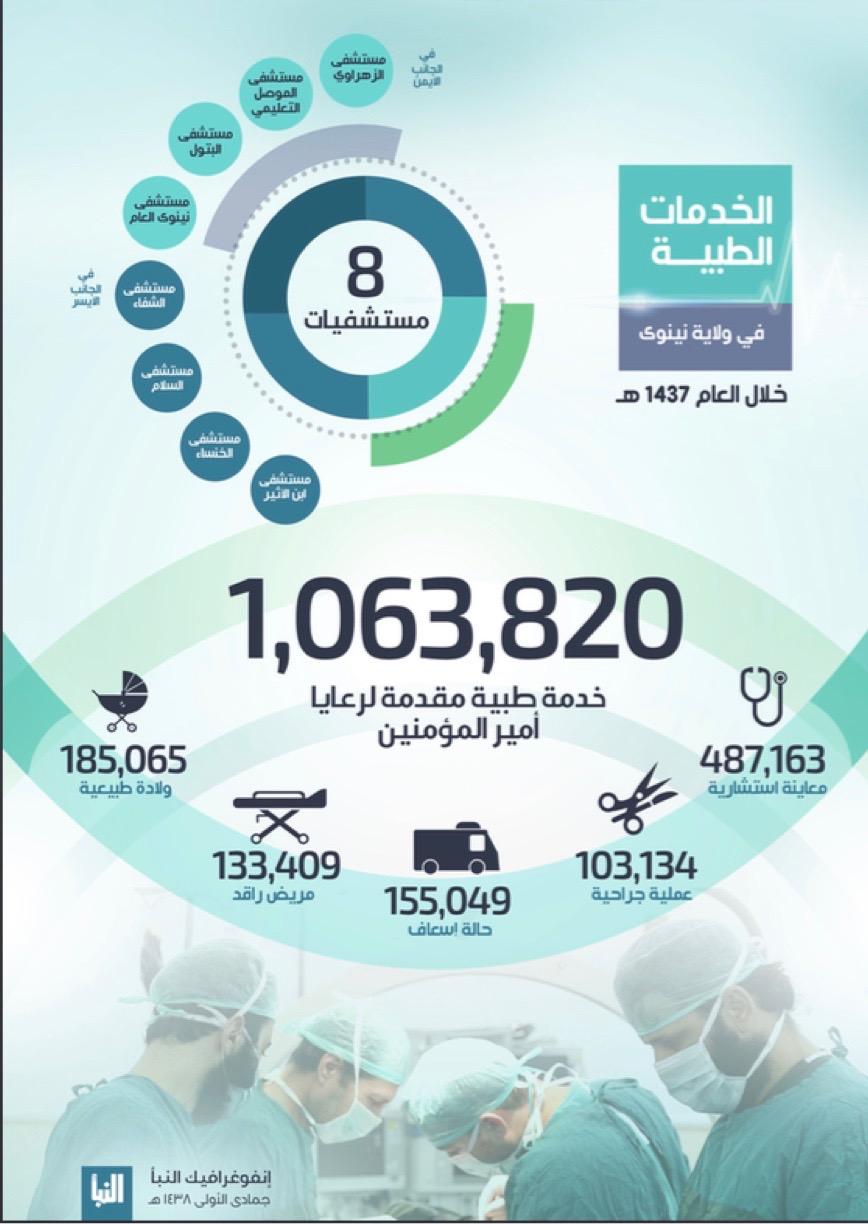
Graphic 3: “Medical services in Ninawa Province in the year 1437” al-Naba’ no. 69
Infographics in al-Naba’ in early 2017 purported to quantify the number of medical services provided through eight hospitals under Daesh rule in and around Mosul. Daesh claimed to have provided 487,163 consultations, 185,065 natural births, 133,409 sick patients treated, 155,049 ambulance rides, and 103,134 surgeries—numbers that are impossible to corroborate. (Graphic 3) A graphic about medical services in Syrian provinces also emphasized the tens of thousands of free services provided. (Graphic 4, below) These infographics neglect to mention having to issue an ultimatum to doctors to return after many fled Daesh rule. They also fail to mention that Daesh acknowledged that some people must be allowed leave its territory for medical treatment, and that it made an exemption for this; otherwise, leaving the territory is equated with apostasy. Such exemptions were not treated lightly, as a car or land had to be offered as collateral in case the sick person didn’t return.
Infographics about education and health services both attempt to paint a smooth picture of services working for citizens, not a public sector shot through with holes from defections and incapable of meeting everyone’s needs. Its aspirations to ‘statehood’ compel Daesh to emphasize its paternal role in protecting and caring for its citizens, but it cannot show them the full reality, only a stage-managed version.

Graphic 6: “Statistics for the first half of 1437 for some provinces of the Islamic State” al-Naba’ no. 31
While much has been made about Daesh exporting oil through illicit networks to fund its activities, the organization cannot survive financially on oil revenues alone. Tax collection figures in al-Naba’ show revenues from al-zakat, an Islamic duty of Muslims to help those in need. Effective tax collection is understood as a central element of a strong state more broadly.4 An infographic from mid-2016 shows statistics for Wilayat Tarablus, the former Tripoli region in Libya, where Daesh claimed that it had distributed more than $878,000 in charity over a three-month period in early 2016. (Graphic 5, below) Another Daesh infographic claimed that the group has distributed more than $8,000,000 to more than 44,000 families in Syria. (Graphic 6) Yet another graphic dealing with zakat emphasized its obligatory status, pushing citizens to see this as an Islamic duty rather than merely a state tax. (Graphic 7, below) Thus Daesh infographics about zakat attempt to demonstrate state capacity, readiness to help those in need, and religious bonafides.
Religious governance in territories controlled by Daesh falls under al-Hisba, the religious police, and various infographics in al-Naba’ attempted to quantify its effectiveness. Daesh shari‘a courts in Syria processed just under sixty-nine thousand cases in the space of six months. (Graphic 1) A graphic focusing on a one-month span in Syria showed that the majority of the Syrian cases were in Al-Raqqa. (Graphic 8) For this period between March and April of 2016, we get the most detailed breakdown: 31% of these cases are described as related to buying or selling during prayer times, 13% related to drugs or smoking, many to “various infractions” like wearing makeup or failing to veil the way Daesh decreed. Daesh claimed to have seized more than one million pills during a six-month period in Syrian provinces, as well as several hundred thousand cartons of cigarettes. (Graphic 1) Remarkably, Daesh quietly tolerated cigarette smuggling and later seized the profits from the smugglers themselves, as another source of revenue in hard times—the theme of controlling vice was quietly superseded by hard financial need. Still, the latent theme of infographics relating to religious vice, even if hypocritical, is that stability through rule of law is one of the most tangible benefits Daesh can offer after years of chaos.
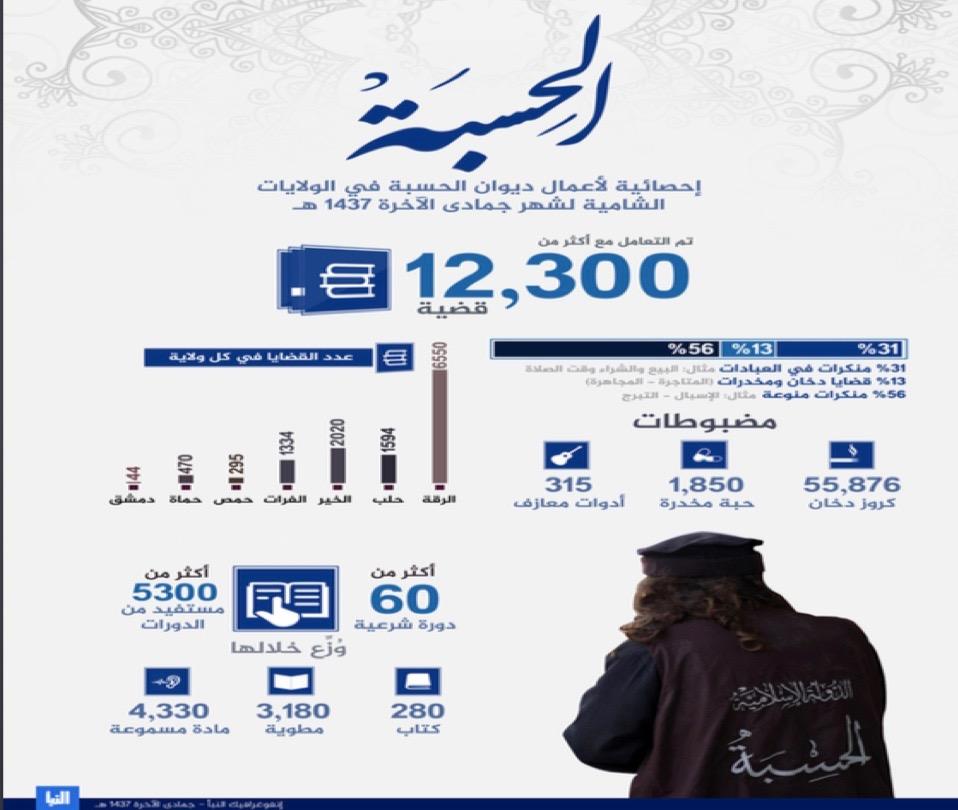
Graphic 8: “Statistics of Diwan al-Hisba in Sham provinces, month of Jamadi al-akhra of 1437" al-Naba’ no. 24
The incomplete reality of Daesh media comes through in archival documents and in testimonies of defectors and others who have fled Daesh rule.5 Contrary to the image of competence that the organization seeks to display, Daesh has struggled with institutional brain drain as its violent system of rule drives away prospective talent. Extreme measures of “repentance” were implemented in which anyone who worked for the Syrian or Iraqi Ba‘ath governments was required to repent for their sin before being allowed to work for Daesh. This insistence on repentance seems to have exacerbated the brain drain problem, as I have argued elsewhere.
Daesh thus saw its aspirations doubted by other jihadis before even moving to realize them, and saw a complete refusal by the West to acknowledge its statehood after the declaration of the Caliphate.
Therefore, as this analysis has tried to show, even if statistics in the infographics are correct, they leave out key problems that change the picture regarding the capacities of these services and institutions. While extreme violence projects one facet of state power, the incompleteness of the Daesh ‘state’ renders it unable to fulfill other basic functions, which also include stable currency production or passport generation. In both of these respects Daesh remains dependent on other states, primarily Syria and Iraq. Daesh cannot manage a modern economy if it cannot print an internationally recognized currency through a central bank. Since the infographics under discussion here were published, Daesh has also lost significant territory, falling further from full statehood and struggling to hold onto what little remains. Daesh media attempt to elide this weakness with displays of strength, dominance, and competence, but the ‘Islamic State’ will remain an incomplete state at best even if it regains territory.
* * * * * * *
Referenced Infographics:
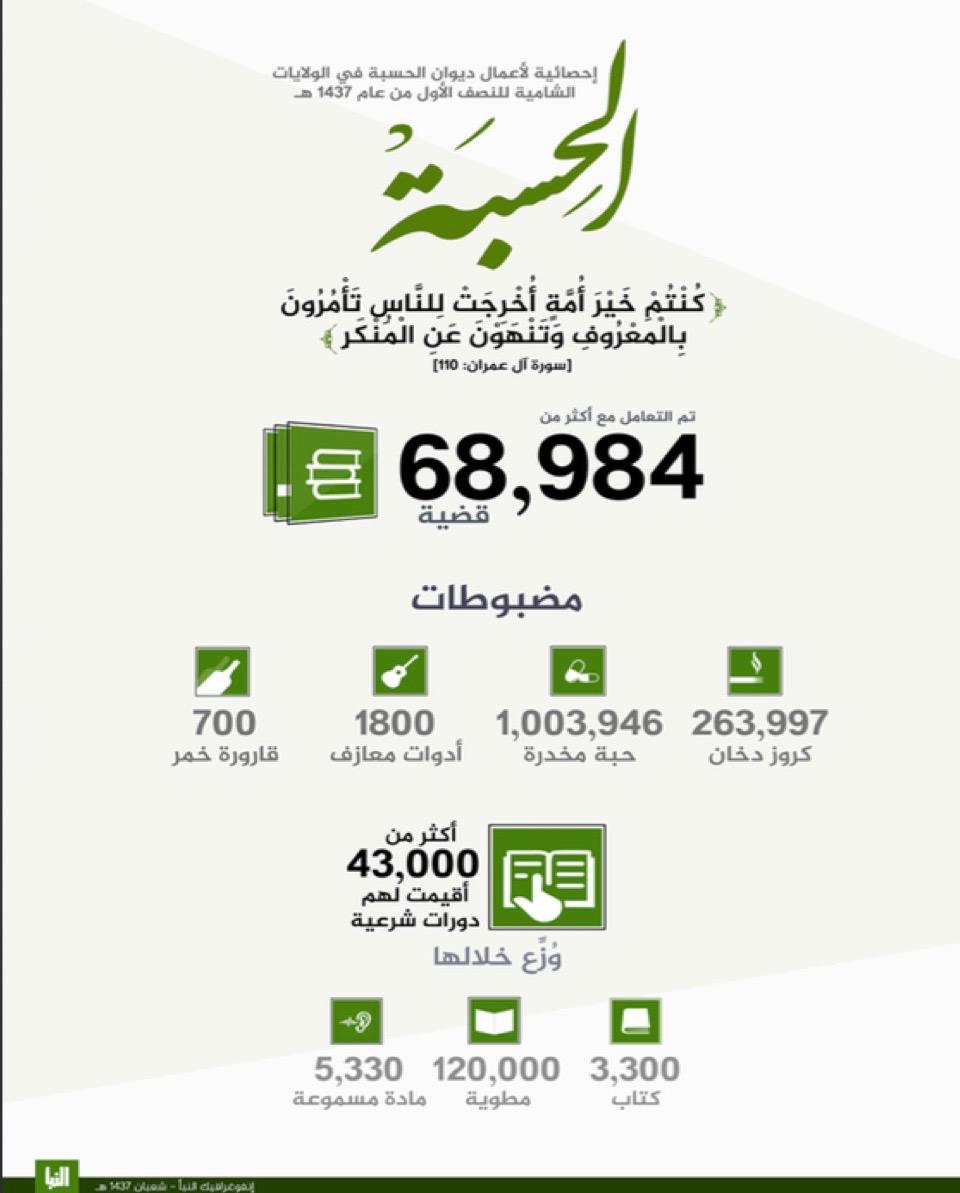
Graphic 1: “Statistics of Diwan al-Hisba in Sham provinces for the first half of 1437” al-Naba’ no. 30
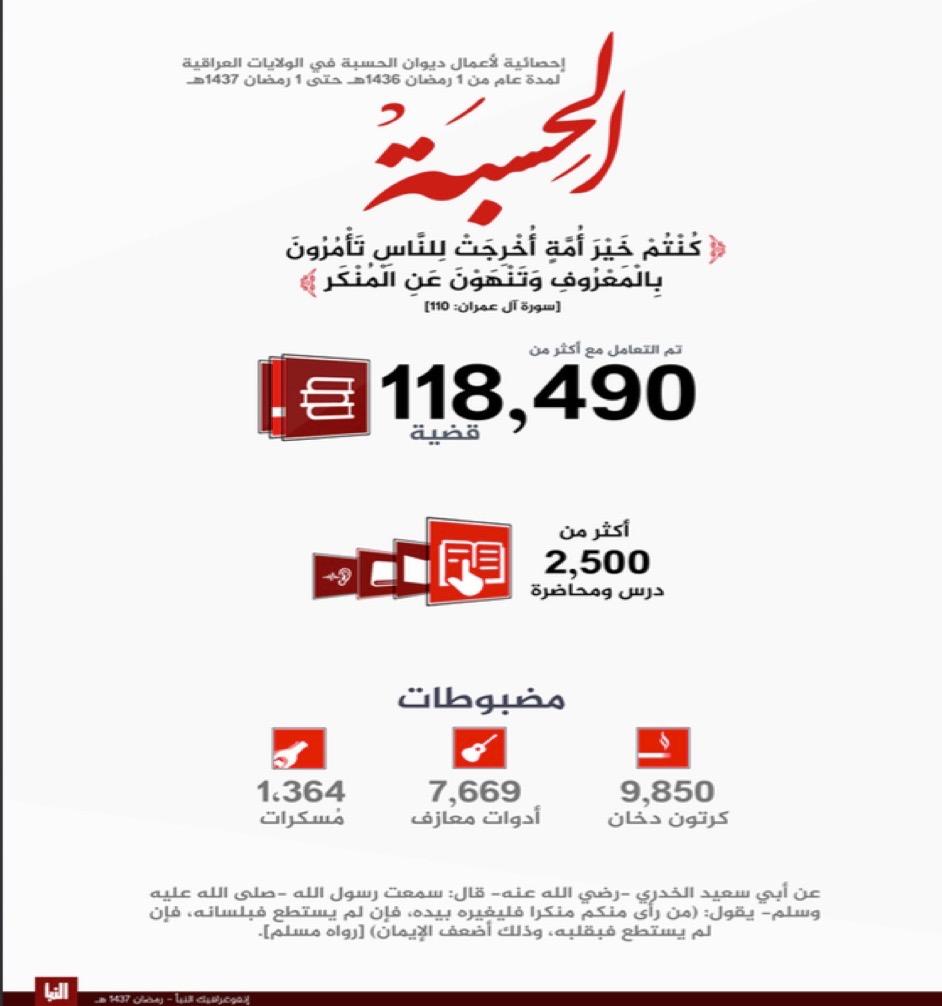
Graphic 2: “Statistics of Diwan al-Hisba in Iraqi provinces for full year from June 2015-June 2016” al-Naba’ no. 37
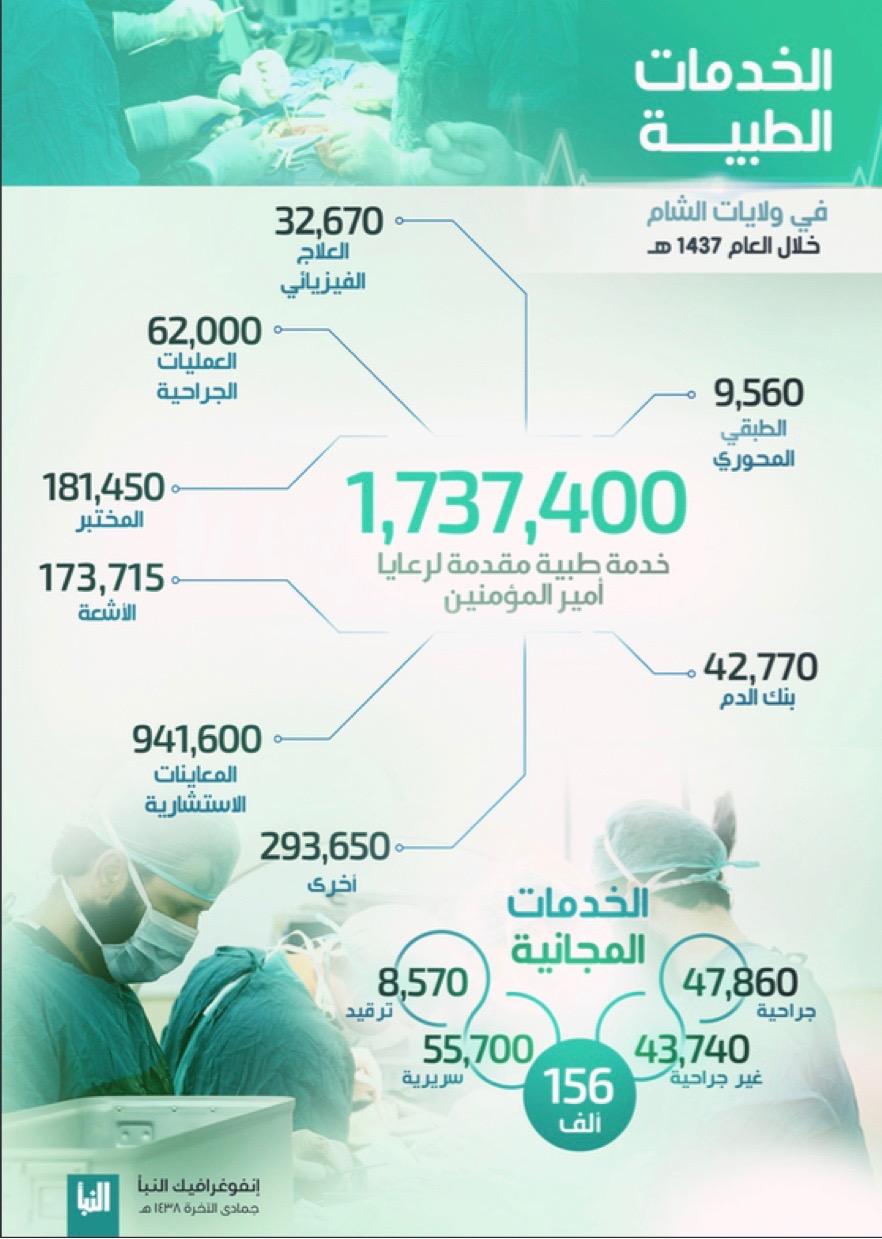
Graphic 4: “Medical Services in Sham Province for the year 1437 hijri” al-Naba’ no. 70

Graphic 5: “Statistics for the second quarter of 1437 Wilayat Tarablus” al-Naba’ no. 32
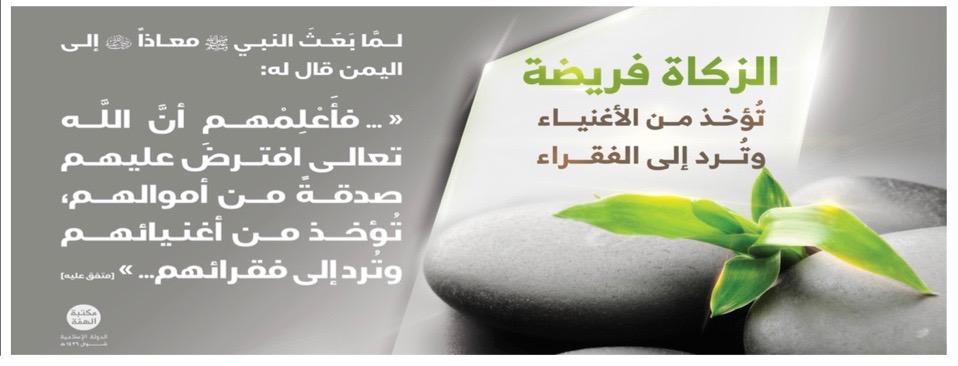
Graphic 7: “Zakat is Obligatory” al-Naba’ no. 46
1. McCants, William. The ISIS Apocalypse. (New York: St. Martins Press, 2015.)
2. Stern, Jessica and Berger, J.M. ISIS: The State of Terror. (New York: HarperCollins, 2015)
3. Whiteside, Craig. “Lighting the Path: The Evolution of the Islamic State Media Enterprise
p.18-19.
4. Migdal, Joel S. Strong Societies and Weak States: State-society Relations and State
5. Samer. The Raqqa Diaries: Escape from the Islamic State. (Penguin, 2017)
INFOGRAPHICS
1. No author “Statistics of Diwan al-Hisba in Sham provinces for the first half of 1437” al-Naba’ no. 30, p. 2
2. No Author “Statistics of Diwan al-Hisba in Iraqi provinces for full year from June 2015-June 2016” al-Naba’ no. 37
3. No Author “Medical services in Ninawa Province in the year 1437” al-Naba’ no. 69, p. 2
4. No Author “Medical Services in Sham Province for the year 1437 hijri” al-Naba’ no. 70, p. 2
5. No Author “Statistics for the second quarter of 1437 Wilayat Tarablus” al-Naba’ no. 32, p. 9
6. No Author “Statistics for the first half of 1437 for some provinces of the Islamic State” al-Naba’ no. 31, p. 2
7. No Author “Zakat is Obligatory” al-Naba’ no. 46, p.15
8. No Author “Statistics of Diwan al-Hisba in Sham provinces for the month of Jamadi al-akhra of 1437” al-Naba’ no. 24, p. 16



